Stourbridge Junction 1928
by Joe Hancock
| Being employed in the Civil Engineering Department of the
Great Western Railway, practically every job entailed a trip to
some station or depot, being a railway enthusiast, Stourbridge
was an interesting station to go to. We travelled by the
7.35a.m. ex-Wolverhampton. This train originated at Wellington
and called at all stations to Stourbridge, it was thus timed to
get workers to Round Oak steel works by 8.00a.m. The train
consisted of 7 four-wheeled coaches, close coupled, and at this
period hauled by No. 3240, one of the '3232' class, 2-4-0 tender
engines which was then working out its last days. By the end of
the year it was condemned. |
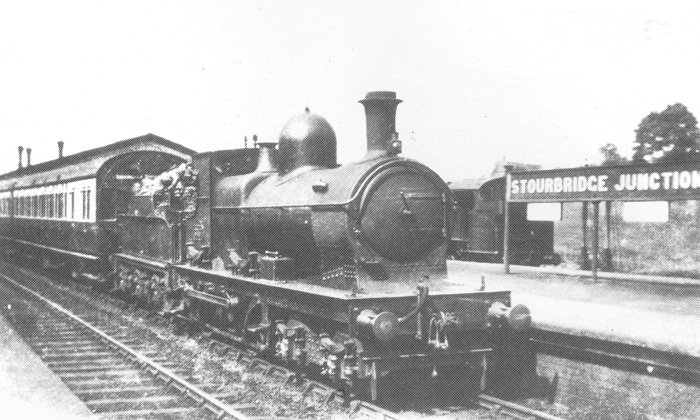
'3521' class 4-4-0 No. 3557 at the head of
a Bewdley train. Photograph by F. Braybrook. Courtesy of Joe
Hancock. |
| The Junction station consisted of two island platforms
with umbrella type verandahs, the whole constructed in 1900.
It was very busy at this period and apart from the Station
Master, supervision warranted the employment of a platform
inspector and foreman on each day-time turn of duty. On
alighting at the station for the first time, one's ears were
afflicted with a strange noise, this was quickly found to be
the brake ejector on steam rail car No. 40, this rail car
met every train at the Junction, conveying passengers from
there to the town station throughout the working day, a
very intensive service. The traffic at the junction was
such that a station pilot was employed from approx. 5.00a.m.
to 1.00p.m., this was usually one of the '3501' class 2-4-0
tender loco's, always with its head to Birmingham, to be
able to assist any passenger train considered overloaded, as
the exit from Stourbridge to Birmingham or Wolverhampton
quickly found a fairly steep bank. The pilot also did a fair
amount of shunting, as at this period set trains had not
arrived. Coaches were added or removed as required,
depending on the amount of traffic.
Milk traffic at this period was still in churns, loaded
into 6-wheeled slat-sided siphon vehicles. These, as they
arrived on country trains were shuffled around to the
appropriate trains, prize cattle in vacuum fitted vehicles
from Kidderminster on Thursday market day, and fruit vans in
the season were also work for the pilot.
There was roughly a one hourly service between 7.00a.m.
and 6.00p.m. These were generally worked by '3600' 2-4-2
tanks, other than those trains which originated at
Wellington or Worcester. This was also the period when the
11.55a.m. stopping train Wolverhampton to Worcester would
consist of 7 four-wheeled coaches with a through coach to
Paddington coupled up to the rear, the
vehicle being an eight-wheeled corridor coach with inset
doors known as 'Concertinas'.
One summer the engine on this train from Wolverhampton
was the 2-4-0 tank No. 617, which was replaced at
Kidderminster for the remainder of the journey to Worcester
by '3521' class 4-4-0 No. 3559.
Local trains to Birmingham could be engined by '3600'
class 2-4-2 tanks and 'Bulldogs' of which Stourbridge had
two, 3345 'Smeaton' and 3359 'Tregeagle'.
A very good service originating from Birmingham passed
through Stourbridge for Worcester, Hereford, and South
Wales, Tyseley depot providing the engine power from
Birmingham, and Hereford in the reverse direction.
Locomotives noted on this working were 'Badminton' class
numbers: 4107 'Alexander Hubbard', 4112 'Oxford', 4115
'Shrewsbury' (these latter two had just lost their names).
'Atbara' class: 4120 'Atbara', 4127 'Ladysmith', 4132
'Pembroke', 4143 'Cape Town'.
'Flower' class: 4149 'Auricula', 4145 'Campanula', 4168
'Stephanotis'. (All from Tyseley shed).
'Bulldog' class: 3324 'Glastonbury', 3326 'Laira', 3327
'Marco Polo', 3328 'Marazion', 3334 'Tavy', 3349 'Lyonesse',
3405 'Empire of India', 3408 'Bombay', 3409 'Queensland'.
(All from Hereford).
Worcester loco's passing through on Birmingham trains were:
3551 'One and All', 3353 'Pershore Plum', 3372 'Sir N.
Kingscote', 3394 'Albany', 3395 'Tasmania', 3400 'Winnipeg',
3404 'Barbados', 3406 'Calcutta', 3408 'Bombay', 3410
'Columbia', 3418 'Sir Arthur Yorke', 3428 and 3436. |
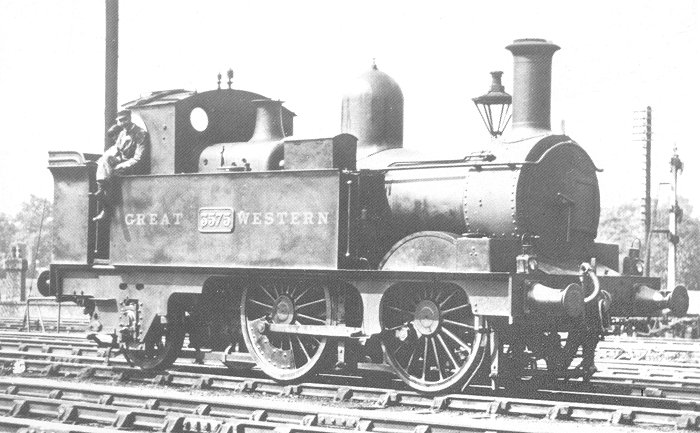
'3571' class 0-4-2 No. 3575 at Stourbridge
Junction. A fine photograph of a Wolverhampton built engine.
Notice the express headlamp code in use, the engine being ready
to assist up the bank. Photo M.R.S. collection. |
| One of the Birmingham based trains passing through en route
to South Wales was a five coach set of eight-wheeled clerestory
coaches, this was an early experiment in electric lighting, one
coach only having an axle driven generator. The rest of the
train was dependent on this vehicle, any vehicle defects meant
stopping the whole set. The train was recognisable by the heavy
electric cables passing from one vehicle to the next at the high
part of the clerestory roof. |
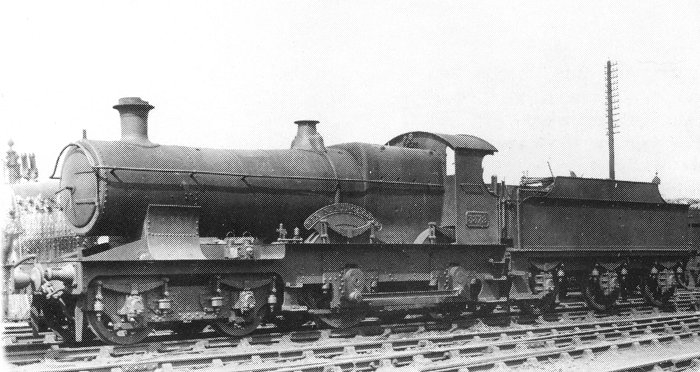
Worcester based 'Bulldog' class 4-4-0 No.
3372 'Sir N. Kingscote' was one of the engines that Joe Hancock
saw passing through Stourbridge Junction in the 1920s, seen here
at Wolverhampton Stafford Road Shed. Photo M.R.S. collection. |
| Freight traffic was fairly heavy, through workings being the
coke trains for the steel works at Bilston, usually engined by a
'2800' 2-8-0 loco. Other trains very often saw the use of '4300'
and '2600' class 2-6-0s, and various 0-6-0 tender types. The
marshalling yard was fairly flat, shunting being carried out by
'1901', '2021' and '2101' class tank engines. Most were in
pannier tank form, but surviving saddle tanks on this work were
2005 of the '1901' class and domeless '2101' class, numbers
2107, 2108, and 2109. |
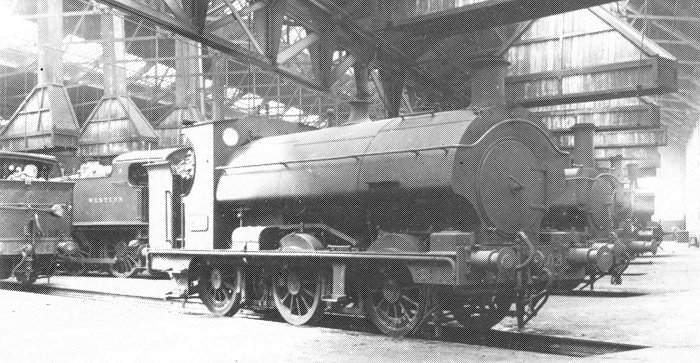
Wolverhampton built '2102' class 0-6-0
saddle tank No. 2106 at Stourbridge Shed. Three domeless saddle
tanks were stationed there, the others being No.s 2107 and 2109.
Photo M.R.S. collection. |
| As traffic built-up in the yard, trips would be organised to
get traffic to industrial areas such as Blowers Green, Round
Oak, Kingswinford, Lye, Cradley, Old Hill, and Halesowen. Trip
engines carried a disc about 15 inches diameter with a number
painted on, black letters on a white background. The disc was
fixed on the engine lamp bracket. Reporting to those who needed
to know was thus simplified. It should be borne in mind that
railway telephone systems pre-war were not as we know them
today. Telephone lines were 'bus-lines', anyone could get in on
the line. This was one of the reasons behind the intensive use
on the Great Western for wagon names, such as 'Open A', 'Macaw
B' etc. |
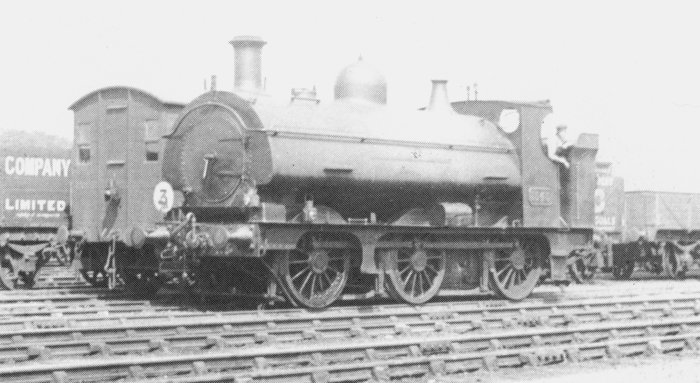
Wolverhampton built '1501' class saddle
tank No. 1545 at Stourbridge Junction. Notice the trip disc
above the buffer beam. Photograph M.R.S. collection. |
| Stourbridge loco. still retained three Beyer Peacock 0-6-0
tanks. No 323 was usually shunting at Cradley, 325 and 327 were
engaged on trip work. Several 'Armstrong' 0-6-0 tender engines
were also used for trip work, one of these loco's still retained
a Gooch 1800 gallon sandwich frame tender, and another an
Armstrong tender, still fitted with coal rails. Banking or
assisting freight engines from the rear was also carried out by
these engines, from Stourbridge to Blowers Green and from
Stourbridge to Rowley Regis. This was not always necessary from
the load point of view, but it did ensure that no breakaways
occurred on the bank, and that everything went out of your
district. No. 510 was often employed on this work, also No. 1015
0f the '360' class. |
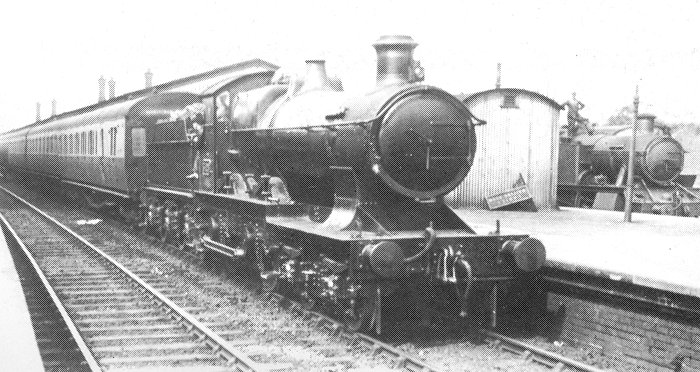
'Bulldog' class 4-4-0 No. 3428 of
Worcester shed, is seen here at Stourbridge Junction on the 24th
June 1932, heading a Birmingham to Worcester train. The
photograph is a little out of period, as is evidenced by the
'set train' behind her engine. Photograph: M.R.S. collection. |
| Halesowen Goods Depot required the services of three
Stourbridge based shunting engines, these were always saddle or
pannier tanks of the '1501' class. One was always shunting at
Halesowen, the other two on trip work to and from Stourbridge,
one on each end of the train to simplify the reversal at Old
Hill. The shunting engines for the yards at Lye, Old Hill, Rowley
Regis, Brettell Lane, Kingswinford, Round Oak, Blowers Green and
Stourbridge Goods were also provided from this depot, together
with the steam rail-motor for the Wolverhampton to Stourbridge
via Wombourn service. The auto-cars for the Dudley to Old Hill
via Windmill End were also provided and serviced, the loco's for
the job being 0-4-2 side tank No. 1155, still with its raised
round top firebox, and 0-6-0 pannier tank No. 2120, fitted with
a domeless Belpaire boiler. Whilst enjoying the great variety
of locomotives and carriages, and the many variations among
individual types, little did we realise that within three years
most of this would be swept away by the heavy influx of new
construction in the form of '5700', '4575, and '5101' class
loco's and coaching sets. |
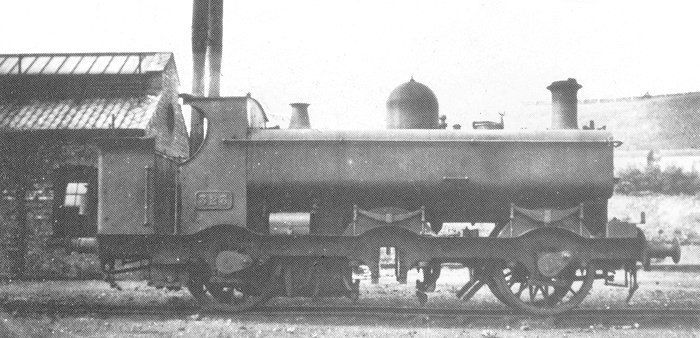
0-6-0 No. 323 was originally a Beyer
Peacock tender engine, rebuilt to saddle tank in 1879. It is
seen here in pannier tank form, minus a part or two, at
Stourbridge on 6th June, 1931. Photograph W. R. Whitworth.
Courtesy of Joe Hancock. |
 |
|

|
|
 |
| Return to
Bushbury Shed |
|
Return to
the Beginning |
|
Proceed to
A Lone Survivor |
|